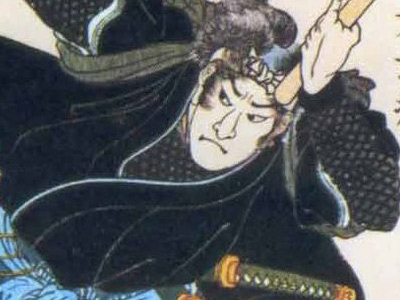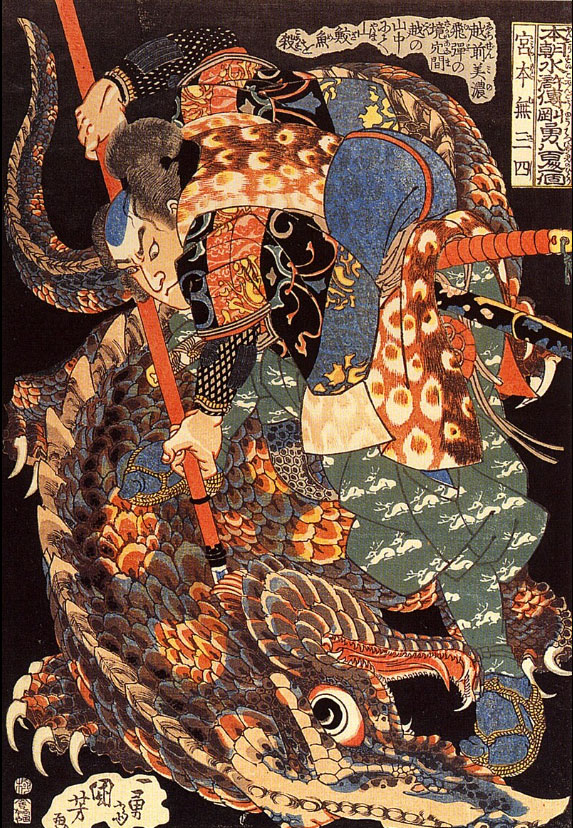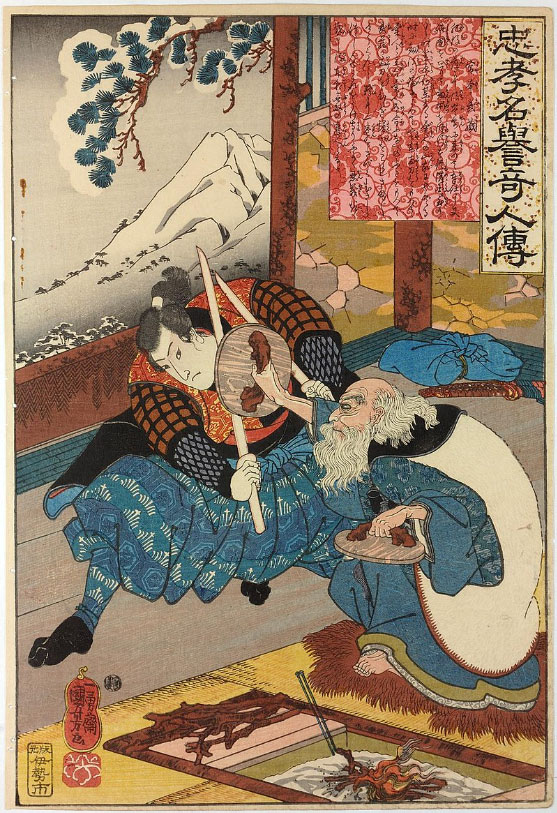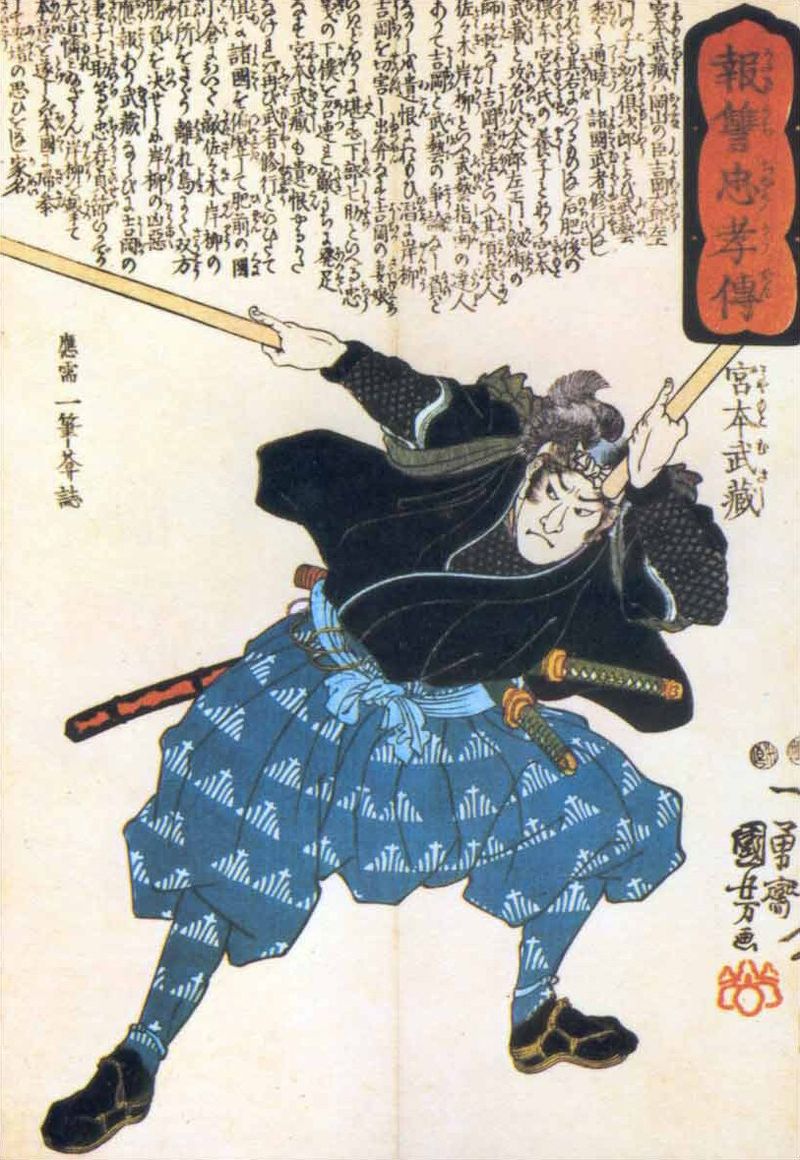Miyamoto Musashi (1584-1645)

Travels and Duels
In 1599, three years later, Musashi left his village, apparently at the age of 15 (according to the Tosakushi, "The Registry of the Sakushu Region", although the Tanji Hokin Hikki says he was 16 years old in 1599, which agrees time-wise with the age reported in Musashi's first duel). His family possessions such as furniture, weapons, genealogy, and other records were left with his sister and her husband, Hirao Yoemon.
He spent his time traveling and engaging in duels, such as with an adept called Akiyama from the Tajima Province.
In 1600, a war began between the Toyotomi and Tokugawa clans. Musashi apparently fought on the side of the Toyotomi's "Army of the West", as the Shinmen clan (to whom his family owed allegiance) had allied with them. Specifically, he participated in the attempt to take Fushimi castle by assault in July 1600, in the defense of the besieged Gifu Castle in August of the same year, and finally in the Battle of Sekigahara. Some doubt has been cast on this final battle, as the Hyoho senshi denki has Musashi saying he is "no lord's vassal" and refusing to fight with his father (in Lord Ukita's battalion) in the battle. Omitting the Battle of Sekigahara from the list of Musashi's battles would seem to contradict The Book of Five Rings's statement that Musashi fought in six battles, however. Regardless, as the Toyotomi side lost, it has been suggested that Musashi fled as well and spent some time training on Mount Hiko.
After the battle, Musashi disappears from the records for a while. The next mention of him has him arriving in Kyoto at the age of 20 (or 21), where he began a series of duels against the Yoshioka School. Musashi's father, Munisai, also fought against a master of the Yoshioka school and won 2 out of 3 bouts in front of the shogun at the time, Ashikaga Yoshiaki who granted him the title of "Unrivaled Under Heaven". The Yoshioka School (descended from either the Tenshin Shōden Katori Shintō-ryū or the Kyo-hachi-ryū) was the foremost of the eight major schools of martial arts in Kyoto, the "Kyo-ryū" / "Schools of Kyoto". Legend has it that these eight schools were founded by eight monks taught by a legendary martial artist resident on the sacred Mount Kurama. At some point, the Yoshioka family also began to make a name for itself not merely in the art of the sword but also in the textile business and for a dye unique to them. They gave up teaching swordsmanship in 1614 when they fought in the Army of the West against Tokugawa Ieyasu in the Battle of Osaka, which they lost. But in 1604, when Musashi began duelling them, they were still preeminent. There are various accounts of the duels — the Yoshioka family documents claim that there was only one, against Yoshioka Kenpō, which Musashi won.
Musashi challenged Yoshioka Seijūrō, master of the Yoshioka School, to a duel. Seijūrō accepted, and they agreed to a duel outside Rendaiji in Rakuhoku, in the northern part of Kyoto on 8 March 1604. Musashi arrived late, greatly irritating Seijūrō. They faced off, and Musashi struck a single blow, per their agreement. This blow struck Seijūrō on the left shoulder, knocking him out, and crippling his left arm. He apparently passed on the headship of the school to his equally accomplished brother, Yoshioka Denshichirō, who promptly challenged Musashi for revenge. The duel took place in Kyoto outside a temple, Sanjūsangen-dō. Denshichirō wielded a staff reinforced with steel rings (or possibly with a ball-and-chain attached), while Musashi arrived late a second time. Musashi disarmed Denshichirō and defeated him. This second victory outraged the Yoshioka family, whose head was now the 12-year-old Yoshioka Matashichiro. They assembled a force of archers, musketeers and swordsmen, and challenged Musashi to a duel outside Kyoto, near Ichijō-ji Temple. Musashi broke his previous habit of arriving late, and came to the temple hours early. Hidden, Musashi assaulted the force, killing Matashichiro, and escaping while being attacked by dozens of his victim's supporters. To escape and fight off his opponents he was forced to draw his second sword and defend himself with a sword in each hand. This was the beginning of his niten'ichi sword style. With the death of Matashichiro, this branch of the Yoshioka School was destroyed.
After Musashi left Kyoto, some sources recount that he travelled to Hōzōin in Nara, to duel with and learn from the monks there, widely known as experts with lance weapons. There he settled down at Enkoji Temple in Banshū, where he taught the head monk's (one Tada Hanzaburo's) brother. Hanzaburo's grandson would found the Ensu-ryū based on the Enmei-ryū teachings and iaijutsu.
From 1605 to 1612, he travelled extensively all over Japan in musha shugyō, a warrior pilgrimage during which he honed his skills with duels. He was said to have used bokken or bokuto in actual duels. Most of the engagements from these times did not try to take the opponent's life unless both agreed, but in most duels, it is known that Musashi did not care which weapon his foe used — such was his mastery.
A document dated 5 September 1607, purporting to be a transmission by Miyamoto Munisai of his teachings, suggests Munisai lived at least to this date. In this year, Musashi departed Nara for Edo, during which he fought (and killed) a kusarigama practitioner named Shishido Baiken. In Edo, Musashi defeated Musō Gonnosuke, who would found an influential staff-wielding school known as Shintō Musō-ryū. Records of this first duel can be found in both the Shinto Muso-ryu tradition and the Hyōhō Niten Ichi-ryū (Miyamoto Musashi's school). The Shinto Muso Ryu tradition states that, after being defeated by Musashi, Muso Gonnosuke spent time developing a stick-fighting technique to counter swords and beat Musashi in a rematch. There are no current reliable sources outside the Shinto Muso Ryu tradition to confirm that this second duel took place.
Musashi is said to have fought over 60 duels and was never defeated, although this is a conservative estimate, most likely not accounting for deaths by his hand in major battles. In 1611, Musashi began practicing zazen at the Myōshin-ji temple, where he met Nagaoka Sado, vassal to Hosokawa Tadaoki; Tadaoki was a powerful lord who had received the Kumamoto Domain in west-central Kyūshū after the Battle of Sekigahara. Munisai had moved to northern Kyūshū and became Tadaoki's teacher, leading to the possibility that Munisai introduced the two. Nagaoka proposed a duel with a certain adept named Sasaki Kojirō. Tokitsu believes that the duel was politically motivated, a matter of consolidating Tadaoki's control over his fief.
HISTORY

RESOURCES
This article uses material from the Wikipedia article "Miyamoto Musashi", which is released under the Creative Commons Attribution-Share-Alike License 3.0.
© Stories Preschool. All Rights Reserved.











